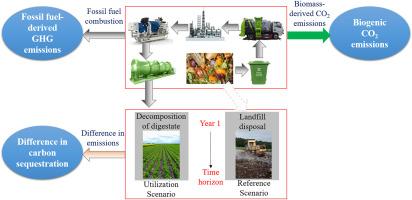High potential of urban area originally inedible food waste for bioenergy to mitigate climate change
IF 9.4
1区 工程技术
Q1 ENERGY & FUELS
引用次数: 0
Abstract
Original Inedible Food Waste (OIFW) represents a significant untapped resource that could generate considerable bioenergy and help combat climate change; however, the potential availability for bioenergy and associated mitigation effects has not been rigorously assessed. Here, we quantified the amount of OIFW available in urban areas worldwide, and evaluated the contribution to climate change and mitigation effect when OIFW was used for producing combined heat and power (CHP). Our analysis revealed that the world’s total potential available OIFW was 11.896–71.204 million ton carbon and could provide 239.911–1197.487 PJ bioenergy. The overall contribution to climate change ranged from −22.567 ± 0.265 to −420.332 ± 10.395 million ton CO2 eq. The maximum possible mitigation effect is estimated at 554.94 ± 10.395 million tons CO2 equivalent (up to 17.9 % of the global CO2 emissions from natural gas-derived electricity and heat), with a minimum effect at around 47.769 ± 0.265 million ton CO2 eq. Therefore, an early deployment of OIFW collection system for CHP is in need to harness OIFW as a resource for bioenergy and a solution for climate change mitigation.

城市地区原本不可食用的食物垃圾转化为生物能源以缓解气候变化的巨大潜力
原始不可食用食物垃圾(OIFW)是一种重要的未开发资源,可以产生大量生物能源并有助于应对气候变化;然而,生物能源的潜在可用性和相关的缓解效应尚未得到严格评估。在此,我们量化了全球城市地区可用的OIFW数量,并评估了OIFW用于热电联产(CHP)时对气候变化的贡献和缓解效果。分析结果表明,全球总潜在可用OIFW为11896 ~ 71204万吨碳,可提供239.911 ~ 1197.487 PJ的生物能源。对气候变化的总体贡献范围为- 22567±0.265至- 420332±1039.5万吨二氧化碳当量。估计最大可能的缓解效应为554.94±1039.5万吨二氧化碳当量(相当于天然气发电和供热产生的全球二氧化碳排放量的17.9%),最小效应约为47769±0.265万吨二氧化碳当量。需要尽早为热电联产部署OIFW收集系统,以利用OIFW作为生物能源资源和缓解气候变化的解决方案。
本文章由计算机程序翻译,如有差异,请以英文原文为准。
求助全文
约1分钟内获得全文
求助全文
来源期刊

Energy
工程技术-能源与燃料
CiteScore
15.30
自引率
14.40%
发文量
0
审稿时长
14.2 weeks
期刊介绍:
Energy is a multidisciplinary, international journal that publishes research and analysis in the field of energy engineering. Our aim is to become a leading peer-reviewed platform and a trusted source of information for energy-related topics.
The journal covers a range of areas including mechanical engineering, thermal sciences, and energy analysis. We are particularly interested in research on energy modelling, prediction, integrated energy systems, planning, and management.
Additionally, we welcome papers on energy conservation, efficiency, biomass and bioenergy, renewable energy, electricity supply and demand, energy storage, buildings, and economic and policy issues. These topics should align with our broader multidisciplinary focus.
 求助内容:
求助内容: 应助结果提醒方式:
应助结果提醒方式:


